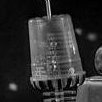Concrete hatch has for a long time been a disappointment for some. The reason being that people are hatching some concrete in Svalbard in a drawing that has its origin on the equator and using mm as units!
When one looks at the hatch definition, the distances and angles are not defined to enough decimal places. So I thought I would try and see if I could do better using trigonometry to calculate the amounts. Non-rational numbers need to be defined to as many decimal places as possible if they are to be used a long way from the origin. But the hatch definition file has a line limit of 80 characters. Any longer than that, and one gets a warning in AutoCAD.
Here is the file definition and a picture of the hatch a long way from the origin. Those able enough can copy the file and overwrite the supplied Concrete Hatch.
*aaconc, updated concrete hatch (random dot and stone pattern)
50, 0,0, 4.1297503417,-5.8978947189, 0.75,-8.25
355, 0,0, -2.0378120728,7.3723683986, 0.60,-6.6
100.4514447435,.598,-.0523,5.73058713914,-6.93976736215,0.63740192,-7.0114211171
46.1842,0,2,6.19462551259,-8.84684207832,1.125,-12.375
96.6356447435,.889,1.862,8.5958807087,-10.4096510432,0.9561028796,-10.5171316757
351.1842,0,2,7.7432818907,11.0585525979,.9,-9.9
21,1,1.5,4.1297503417,-5.8978947189,0.75,-8.25
326,1,1.5,-2.0378120728,7.3723683986,0.6,-6.6
71.4514447435,1.497,1.164,5.73058713914,-6.93976736215,0.6374019197,-7.011421117
37.5, 0,0, 2.123,2.567, 0,-6.52,0,-6.7,0,-6.625
7.5, 0,0, 3.123,3.567, 0,-3.82,0,-6.37,0,-2.525
-32.5, -2.23,0, 4.6234,2.678, 0,-2.5,0,-7.8,0,-10.35
-42.5, -3.23,0, 3.6234,4.678, 0,-3.25,0,-5.18,0,-7.35
*eldon
